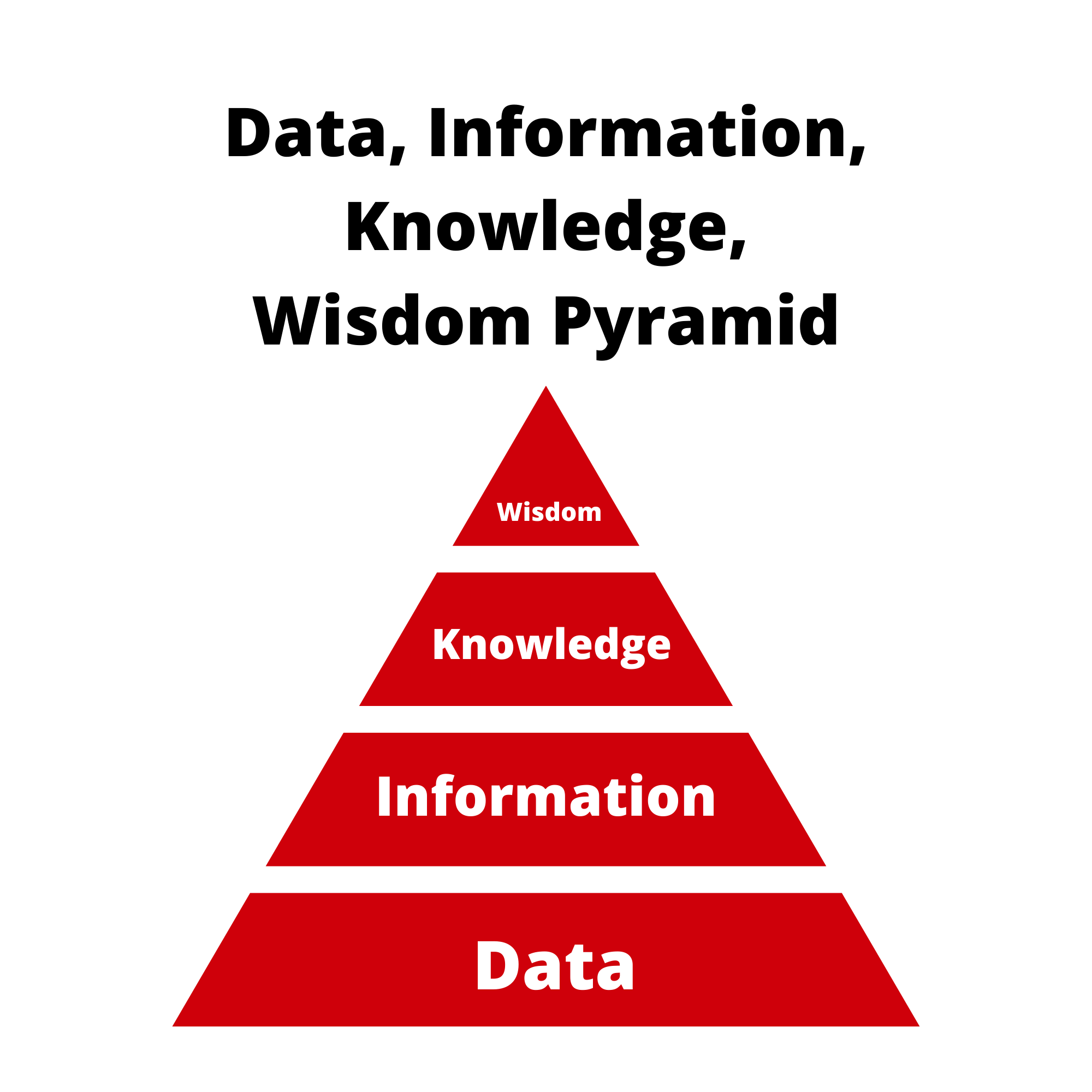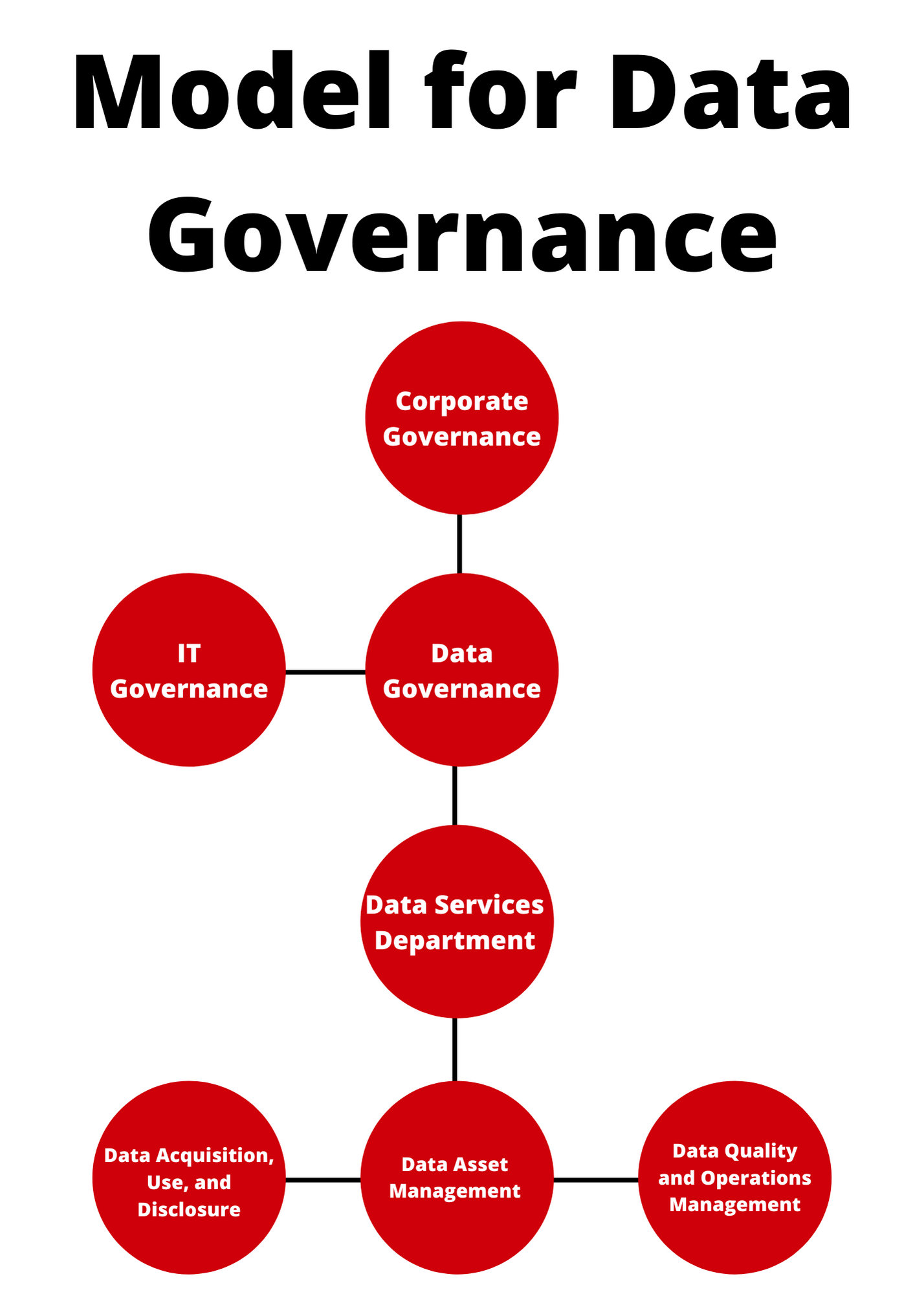Section 3: Data Governance
Dr. Sinéad McElhone; Sherri Hannell; and Noah James

Section Overview
This section aims to provide an understanding of what data governance is and how it supports data literacy. The importance of data governance is highlighted and the concept of data architecture and the role of a data architect is explored.
Section Objectives
By the end of this section, you will be able to:
- Define the term data governance;
- Describe the differences between data governance and data management; and
- Understand the role of data architects.
Test Your Knowledge
Complete the following activity to assess how much you already know about the content that will be covered in this section.
Data Governance
Data governance is the set of authorities, accountabilities, and controls to formalize and consistently guide the management of data assets. Data governance and data management are not the same thing. Data governance establishes how data should be managed through the creation of policies, standards, etc., while data management enacts those policies and standards to gather and use data. It is the organizational structures, data owners, policies, processes, and controls for the beginning to the end lifecycle of data. Data management is the implementation of data governance and enables the execution and controls to achieve data governance. Data governance does not exist without data management and vice versa; data governance without implementation is just documentation.
Consider the following definition from Fircan (2021b):
Data governance is “a discipline which provides the necessary policies, processes, standards, roles, and responsibilities needed to ensure that data is managed as an asset”.
In essence, data governance is the creation of consistent processes to define and provide the steps to clean data, make it accessible to the right individuals, and ensure that it is secure.
Watch the video below to learn more about the difference between data management and data governance:
In contrast to data governance, data management is the “business function of planning for, controlling, and delivering data” (Fircan, 2021b).
In essence, it is the act of implementing processes using technologies, the act of ensuring the proper management of access as part of the responsibilities of individuals in their role, etc.
Data governance establishes a mechanism to manage, control, and oversee data asset management practices. It includes defining the policies, standards, and guidelines for data management, monitoring, evaluating, and improving data asset management practices, as well as enabling practices through knowledge exchange and translation.
Data Governance Differs from Information Governance
As outlined in Section 1: Introduction to Data and Data Literacy, data are facts and statistics in their raw form. Information is data that has been processed, interpreted, organized, and presented to make it meaningful. Data is used in the creation of information.
The Data, Information, Knowledge, Wisdom Pyramid represents the relationship between data, information, knowledge, and wisdom. Each step up the pyramid adds value to the initial data. The more data is enriched with meaning and context, the more information is derived from it, which increases knowledge and creates wisdom. At the top of the pyramid, knowledge and insights have been turned into a learning experience. This guides our actions, which creates wisdom.

Similarly, data governance differs from information governance in that it is specific to the governance of data, not information. Data governance is specific to the governance of data and does not include an approach to governing information. The term data is not used interchangeably with the term information. The analysis, interpretation, and presentation of data to tell a story makes it information. Data governance pertains only to data; information governance pertains to information. Data governance is the subdomain of information governance that provides for the design and execution of data planning and data quality assurance to achieve the strategic information needs of an organization.
Why is Data Governance Important?
Data is an important asset for all organizations and requires active management. Data governance helps to ensure that data is usable, accessible, and protected. Effective data governance leads to better data analytics, which in turn leads to better decision-making and improved operations support. It helps to avoid data inconsistencies or errors, which can lead to poor decision-making or integrity issues.
Data governance ensures that data is:
- Secured: Data is protected from unauthorized access or tampering;
- Trustworthy: Data is correct and consistent;
- Documented: Data is described to make it easier to identify, use, retrieve, and manage;
- Managed: Data is considered a valuable resource and reliable methods are used to access, cleanse, store, and use data; and
- Audited: Data is examined to ensure quality, proper access, and storage.
Data governance also plays an essential role in regulatory compliance, ensuring that organizations are consistently compliant with all levels of regulatory requirements. This is key for minimizing risks and reducing operational and reputational costs.
At its core, data governance leads to improved data quality, decreased data management costs, and increased access to data for all stakeholders. The result is better decision-making and better organizational outcomes.
Key Functions to Enable the Delivery of Data Governance
There are many approaches to developing a data governance program within an organization. In order to better understand the application of data governance within an organization, as well as some of the key roles involved, let’s start with an example of a possible structure for the delivery of data services within an organization.
Data Governance Steering Committee
To provide strategic direction for the management and use of data, a data governance committee is established. The committee acts as the oversight body for strategic data management initiatives that are created to deliver organizational objectives.
The strategy for, and organizational-wide approach for, ensuring that governance programs span the whole corporation generally starts with a steering committee comprised of senior management. Templar (2017), author of Get Governed: Building World Class Data Governance Programs, says steering committee members’ responsibilities include setting the overall governance strategy with specific outcomes, championing the work of data stewards, and holding the organization accountable to timelines and outcomes.
This is an example of a model for data governance:

Data Owners
Templar (2017) says data owners are individuals responsible for ensuring that information within a specific data domain is governed across systems and lines of business. They are generally members of the steering committee. Data owners are responsible for activities such as:
- Approving data glossaries and other data definitions;
- Ensuring the accuracy of information across the enterprise;
- Directing data quality activities;
- Working with other data owners to resolve data issues; and
- Providing the steering committee with input on software solutions or policies.
Data Services Department
A data services department may be created within an organization to ensure that data is managed as a strategic asset throughout the organization. Data services departments are the doers. They enable the strategic direction provided by the data governance steering committee. It is the mandate of data services to:
- Ensure that trusted data is used to support organizational objectives;
- Ensure that data is used and managed in a secure and privacy-sensitive manner; and
- Ensure that data assets drive value across the organization.
Below is an example of a Data Services Department structure. This is only one example for illustration purposes – Data Services Departments can be structured in various ways.
The three functions defined above are ultimately responsible for ensuring that data assets are secured, trustworthy, documented, managed, and audited, and for meeting the strategic objectives of the data governance steering committee, all of which comprise the delivery of successful data governance.
QUICK SIDENOTE: Career Spotlight – Data Steward
Data stewards are accountable for the day-to-day management of data. They are subject matter experts who understand and communicate the meaning and use of information. Data stewards drive accountability for data assets, help improve operational efficiencies, and reduce risks, misunderstandings, and redundancies that arise over who is responsible for data asset management.
Accountabilities for data stewards include:
- Works with required stakeholders to translate the intake requirements to detailed data lifecycle management requirements;
- Provides oversight of specific data assets with the support of appropriate governance structures to ensure that the data assets are efficiently managed and maintained in accordance with any policies and procedures;
- Ensures data lifecycle management requirements are provided to the internal teams to implement and operationalize;
- Facilitates development of data competencies and toolkits; and
- Works with internal teams to implement or modify governance, frameworks, and policy, procedure, or process requirements for assigned data assets.
Data governance ensures that data captured and the subsequent information derived is useful, available, and secure. Good data governance equates to better quality data, improved data analytics, and leads to evidence-based decision-making. It also helps to prevent inconsistencies or errors in data, which can result in data integrity concerns, lack of trust in the data, and poor decision-making.
In the video below, Professor George Fircan details his learning journey from a data governance perspective:
Data ethics involves the knowledge that allows a person to acquire, use, interpret, and share data in an ethical manner including recognizing legal and ethical issues (e.g., biases, privacy) (Statistics Canada, 2020). It is important because it provides parameters for what organizations can and cannot do with the data they collect. In this article, Dr. Mark van Rijmenam (2014) writes about the four guidelines organizations should adhere to regarding the ethical use of data: (1) Radical transparency; (2) Simplicity by design; (3) Preparation and security; and (4) Privacy.
In this blog, Stephen Watts (2020) speaks to the issues of data governance. His key messages focus on the importance of a high-quality governance strategy, what this involves, who needs to be involved within an organization, and implementing strategies to ensure data is used properly, securely, and in compliance with regulatory requirements.
A Key Facet in the Delivery of Data Governance: Data Architecture and the Role of a Data Architect

Data architecture is a one of the key facets of data governance and serves as a foundation for the delivery of a data governance model. The concepts of data governance and data architecture are interrelated – it is impossible to successfully deliver data governance without a solid architecture.
Data architecture is a set of rules, models, policies, or standards that govern which data is collected, and how it is acquired, stored, arranged, secured, accessed, and used (Olavsrud, 2022). It also involves the technologies used to collect, manage, and store the data and the controls placed upon those technologies.
Data architecture is important as it enables better understanding of the data. It provides guidelines for managing data throughout its lifecycle, from creation to destruction. It provides a “blueprint” of data assets, how they are collected, processed, and provisioned.
QUICK SIDENOTE: Career Spotlight – Data Architect
A data architect plays a key role in the creation of an organizational data architecture. They design, maintain, and build models to ensure that data is structured and integrated in a way that enables data to be readily used. This role works collaboratively to identify appropriate architectures to manage data assets in a secure, efficient, and consistent manner.
According to Olavsrud (2022):
Data architects are senior visionaries who translate business requirements into technology requirements and define data standards and principles. The data architect is responsible for visualizing and designing an organization’s enterprise data management framework. This framework describes the processes used to plan, specify, enable, create, acquire, maintain, use, archive, retrieve, control, and purge data. (para. 1)
For example, public health data is any data relating to both the health of individual patients and the collective population. It is gathered from a series of health information systems. A data architect in a public health unit would support public health objectives by designing dynamic public health databases and information systems to enable effective monitoring and disease surveillance. They would define how the data would be stored, consumed, integrated, and managed by different systems, as well as any applications using the data.
Responsibilities of data architects include:
- Design, maintain, and build models to ensure data is structured and integrated in a way that it is readily consumable;
- Provide data architecture (e.g., data modelling, database structure) expertise to support discussions;
- Work collaboratively to identify appropriate architecture to manage data assets in a secure, efficient, and consistent manner;
- Provide industry best practice and other technical concepts that support the development and improvement of the governance of the data asset management lifecycle;
- Key point of contact for additional technical support;
- Provide input (e.g., enterprise risk, issues, impacts, options, etc.) into decisions or assessments being performed; and
- Advise and inform members on data architecture area risks, inefficiencies, quality concerns, and other areas requiring improvement.
Data Governance and OCAP® Principles
According to the First Nations Information Governance Centre (n.d.):
The First Nations principles of OCAP® establish how First Nations’ data and information will be collected, protected, used, or shared. Standing for ownership, control, access, and possession, OCAP® is a tool to support strong information governance on the path to First Nations data sovereignty.
OCAP® was established in 1998 during a meeting of the National Steering Committee (NSC) of the First Nations and Inuit Regional Longitudinal Health Survey, a precursor to the First Nations Regional Health Survey (FNRHS, or RHS). Originally, OCAP® began as “OCA” with the members of the NSC affixing a “P” soon after to acknowledge the importance of First Nations’ people possessing their own data.
There is no law or concept in Western society that recognizes community rights and interests in their information, which is in large part why OCAP® was created. OCAP® ensures that First Nations own their information and respects the fact that they are stewards of their information, much in the same way that they are stewards over their own lands. It also reflects First Nation commitments to use and share information in a way that maximizes the benefit to a community, while minimizing harm.
Watch the video below, which covers the First Nations Information Governance Centre’s mission, provides an overview of its work, and explores the importance of OCAP® for First Nations people and communities:
Please go to Section 3: Indigenous Data Sovereignty in Chapter 2: Data for Equity? for more information about this topic.
Deeper Dive
- For those who wish to learn more, the First Nations Information Governance Centre offers The Fundamentals of OCAP®, an online training course developed in partnership with Algonquin College Corporate Training. This self-guided course takes learners through seven modules that are designed to introduce the fundamental concepts of OCAP®, information governance, and First Nations data sovereignty: https://fnigc.ca/ocap-training/take-the-course
- Want to learn more about the many facets of data governance? The DAMA Organization (DAMA) is an international not-for-profit, vendor-independent, global association of technical and business professionals dedicated to advancing the concepts and practices of information and data management. DAMA International’s primary purpose is to promote the understanding, development, and practice of managing data and information as key enterprise assets to support the organization. If you are interested, DAMA has a variety of certifications available for you to undertake with regards to data management and these are internationally recognized and would be useful for any student interested in delving into this topic in more detail: https://www.dama.org/cpages/home
Summary
Data governance is a set of accountabilities and controls to ensure that data is usable, accessible, and protected. Effective data governance leads to better data analytics, which in turn leads to better decision-making and improved operations support. Data architecture is the technology or infrastructure that plays a vital role in supporting data governance. The role of a data architect is instrumental in the creation of a viable data architecture.
Test Your Knowledge
Complete the following activity to assess how much you learned about the content that was covered in this section.
A discipline which provides the necessary policies, processes, standards, roles, and responsibilities needed to ensure that data is managed as an asset (Fircan, 2021b).
The ability to understand and communicate data as information (Jackson & Carruthers, 2019).
A set of rules, models, policies, or standards that govern which data is collected, and how it is acquired, stored, arranged, secured, accessed, and used (Olavsrud, 2022).
A named collection of related data elements that is formally managed as a single unit. They may be a collection of facts represented as text, numbers, graphics, images, sound, or video, and are the raw material from which information can be derived and decisions can be made.
The business function of planning for, controlling, and delivering data (Fircan, 2021b).
The knowledge and skills to determine if data is 'clean' and if not, using the best methods and tools to take necessary actions to resolve any problems (Statistics Canada, 2020).
A collaboration involving regular sharing of information, ideas, and experience between those who generate knowledge and those who might put the knowledge to use (Reardon et al., 2006).
A dynamic and iterative process that includes synthesis, dissemination, exchange, and ethically sound application of knowledge to improve the health of Canadians, provide more effective health services and products, and strengthen the health care system (Canadian Institutes of Health Research, 2012, p. 1).
The synthesis, exchange, and application of knowledge by relevant stakeholders to accelerate the benefits of global and local innovation in strengthening health systems and improving people’s health (World Health Organization, 2005, p. 2).
Facts and statistics in their raw form, collected for reference, analysis, or decision-making.
The interrelated conditions in which something exists or occurs (Merriam-Webster, 2022).
The knowledge and skills to assess data sources to ensure they meet the needs of the gatherer or organization (Statistics Canada, 2020). This includes both identifying errors and taking action to address the issues with the data.
The knowledge and skills required to use data to help in the decision-making and policy-making process (Statistics Canada, 2020). This includes thinking critically when working with data, formulating appropriate business questions, identifying appropriate datasets, deciding on measurement priorities, prioritizing information garnered from data, converting data into actionable information, and weighing the merit and impact of possible solutions and decisions.
The knowledge that allows a person to acquire, use, interpret and share data in an ethical manner including recognizing legal and ethical issues (e.g., biases, privacy) (Statistics Canada, 2020).
The knowledge and skills required to apply advanced statistical and analytic techniques and tools (e.g., regression, machine learning, data mining) to perform data exploration and build accurate, valid and efficient modelling solutions that can be used to find relationships between data and make predictions about data (Statistics Canada, 2020).

